Playrix: how to buy traffic correctly?
Anna Krizhanovskaya, Head of Social UA at Playrix, spoke in as much detail as possible about the difficulties that developers may face when buying traffic.
The report was read at White Nights St.Petersburg 2017. We have prepared a printed version of the speech.

Anna Krizhanovskaya
The article in front of you is about how not to buy traffic more expensive than necessary, how not to overpay for it.
What is traffic?
Let’s start with a simple one, with an answer to the question, what is traffic?
Traffic is our audience, users who play our games, those whom we “buy”, to whom we show our ads.
You should always remember that traffic is people.
Why do I need traffic?
Everyone needs traffic. When we buy a valuable user, when we try to buy him, we compete with dozens, hundreds, thousands of advertisers. Among them are games, news applications, utilities, and brands.
Why is everyone so desperate for traffic?
New applications need it in order to get into the tops, get promoted, get their audience.
Well—known games, such as, for example, Playrix projects, already have their own players. Nevertheless, we continue the process of buying traffic, trying to buy more and more.
Why are we doing this?
The answer is prosaic: because if you don’t have a brand of the same strength as Coca-Cola or Lay’s, and you won’t buy advertising, they will simply forget about you.
If the game does not have an updated audience, then the game will simply disappear, everyone will forget about it, because “old” users will not play forever, sooner or later they will stop playing this game, go to some other. The game will come to naught, “go out”. Therefore, it is very important to update the audience.
The main ways to get traffic
How to update the audience? There are three main ways.
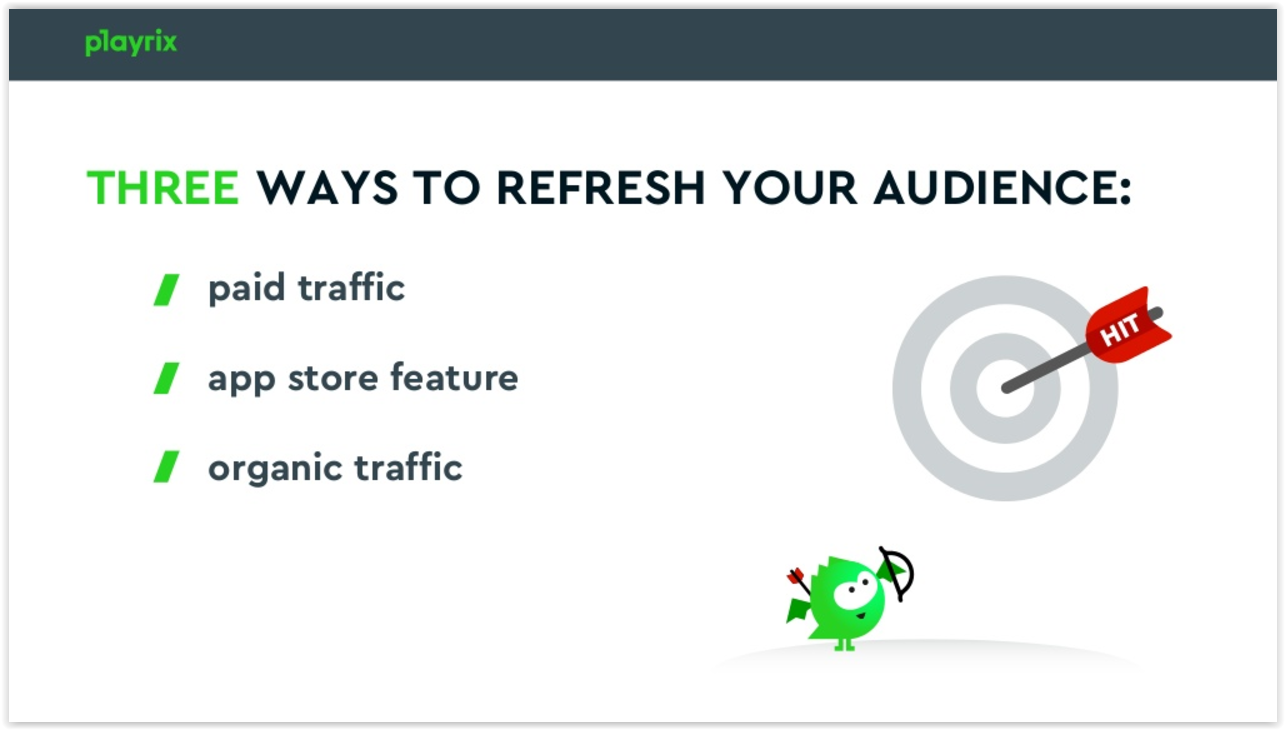
1. Purchase of paid traffic
Paid traffic is directly the advertising that we buy from various sources. These are video grids, where we spin in various applications and publishers, these are social networks, YouTube, search traffic, and anything.
The volume of paid traffic is limited only by budgets, and its quality can be controlled.
2. Feathering
Feature—sharing is a good thing, it’s placing your app in one of the collections of app stores. He is good because he promotes you for free, due to the support of the store.
However, the feathering cannot be infinite. Plus, the traffic that comes during the feature is heterogeneous. This is not a premium audience, but people who like to watch various novelties in the store. After seeing your application in the selection and looking at it, in a week they can just go to another application that is featured there. Therefore, it is not necessary to count on feathering in terms of a high-quality audience.
3. Organic traffic
Organic is the traffic that comes to you by itself. These are people who heard from friends about your app, or saw it in the “Similar” section and installed it themselves.
About organic traffic, you should understand this thing: if you are interested in large volumes of traffic, then you need to remember that organic traffic without paid traffic will come to naught. That is, if you stop buying paid traffic, your organic traffic volumes will gradually deflate.
Types of games and approaches for purchasing traffic for them
Games are paid, free without internal purchases and free with internal purchases. Depending on the type of game, approaches to the purchase of traffic are fundamentally different.
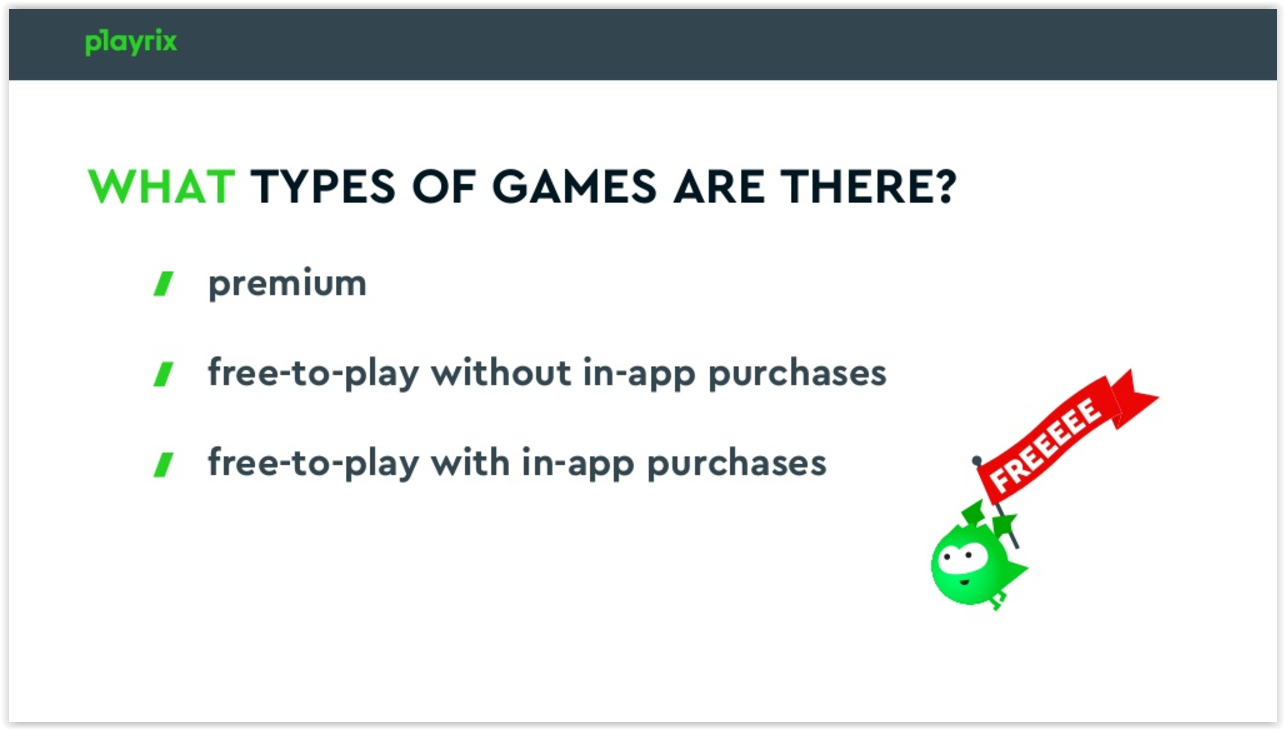
You can buy traffic just for volume. You “drive” traffic, get a huge audience and work with it. She’s playing your games, sitting in your apps.
The second goal is revenue generation. This is already directly earning on your traffic.
Now let’s correlate these goals with the types of games.
Paid games are monetized directly through installation. Accordingly, it is very difficult to promote them. Imagine: you are scrolling through the Facebook feed and see two ads. The first one says “Free game, download right now”. The second one says “Paid game, costs $10, download now”. Which game will you download? I think that almost everyone will choose an ad for a free game. Accordingly, the purchase of traffic is very limited here.
The second type is free games that do not have any purchases inside. Accordingly, publishers who release games of this type can earn on internal advertising. They embed ads in the application and earn directly from the fact that they spin ads inside the application and receive income for impressions. Naturally, for this type of games, it is important to purchase traffic in order to “drive” as many volumes as possible.
And, accordingly, the third type. Playrix is just releasing games of this type. Here the publisher earns at the expense of a quality audience. The main goal is to purchase high—quality players who are likely to convert into paying ones.
We are now focusing on the third type, because this is the most interesting. Buying traffic simply in large volumes is not such a difficult task.
Types of traffic and its quality
On any advertising channel, be it a video grid, a social network or any other platform, there will always be a certain categorization of traffic into three types, based on demand for it. This will be a top audience, “middle-class” and smaller sources that are either new or not very popular.
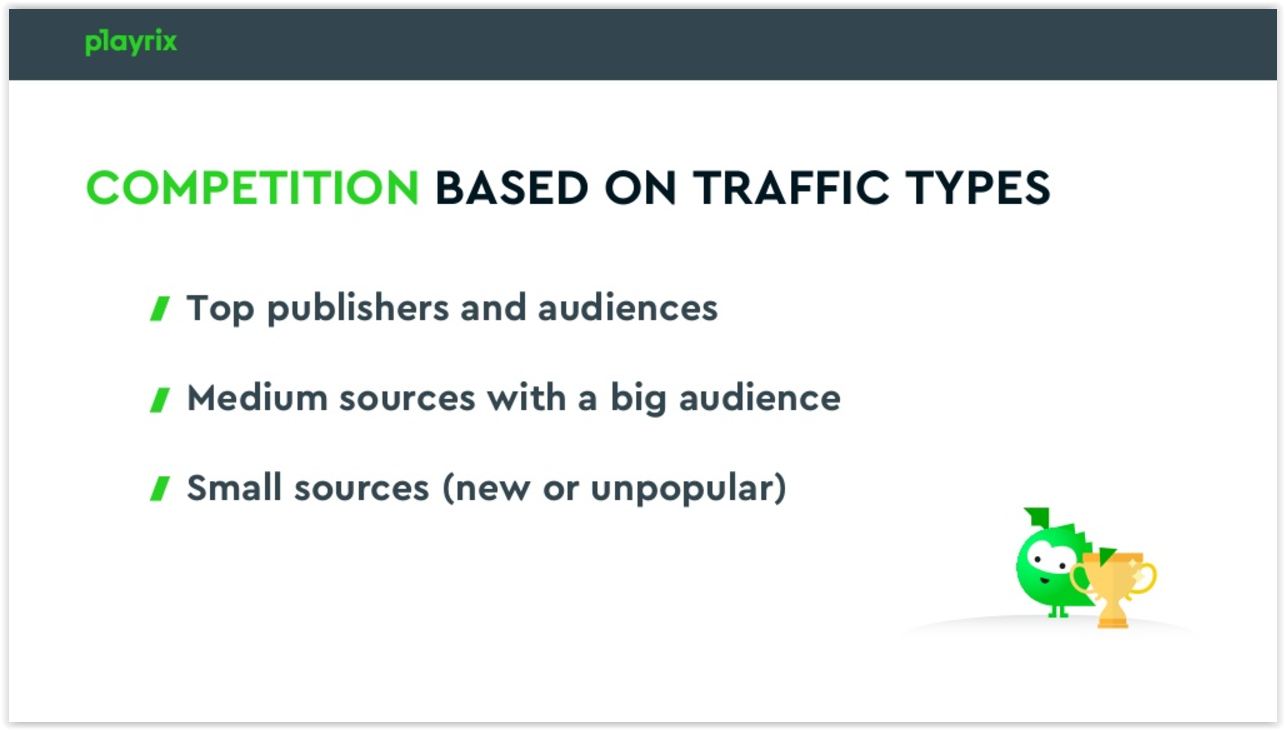
All these categories are bought. Each of them has its own buyer.
Small sources are usually bought en masse.
Average sources are those applications in which there are a lot of players, while the traffic quality itself is average. Not many companies are interested in such traffic. Here it turns out that the supply exceeds the demand, so the competition is not so great.
The top audience is the one that will give the maximum profit. It is for her that the real struggle is unfolding.
It is very important to focus on this audience, find it on each channel, highlight it and properly compete for it with other advertisers.
How do advertising channels work?
In order to properly purchase good publishers, you need to understand how channel algorithms work. You are not the only advertiser who works on this channel. There are a lot of others who also want to buy both top publishers and top audiences, and want to buy more and more of them.
Therefore, it is essential, in our opinion, to understand how the channel mechanism works, how advertising is shown and how the auction works.
Let’s take a brief look at what generally happens at the moment when a user sees an ad.
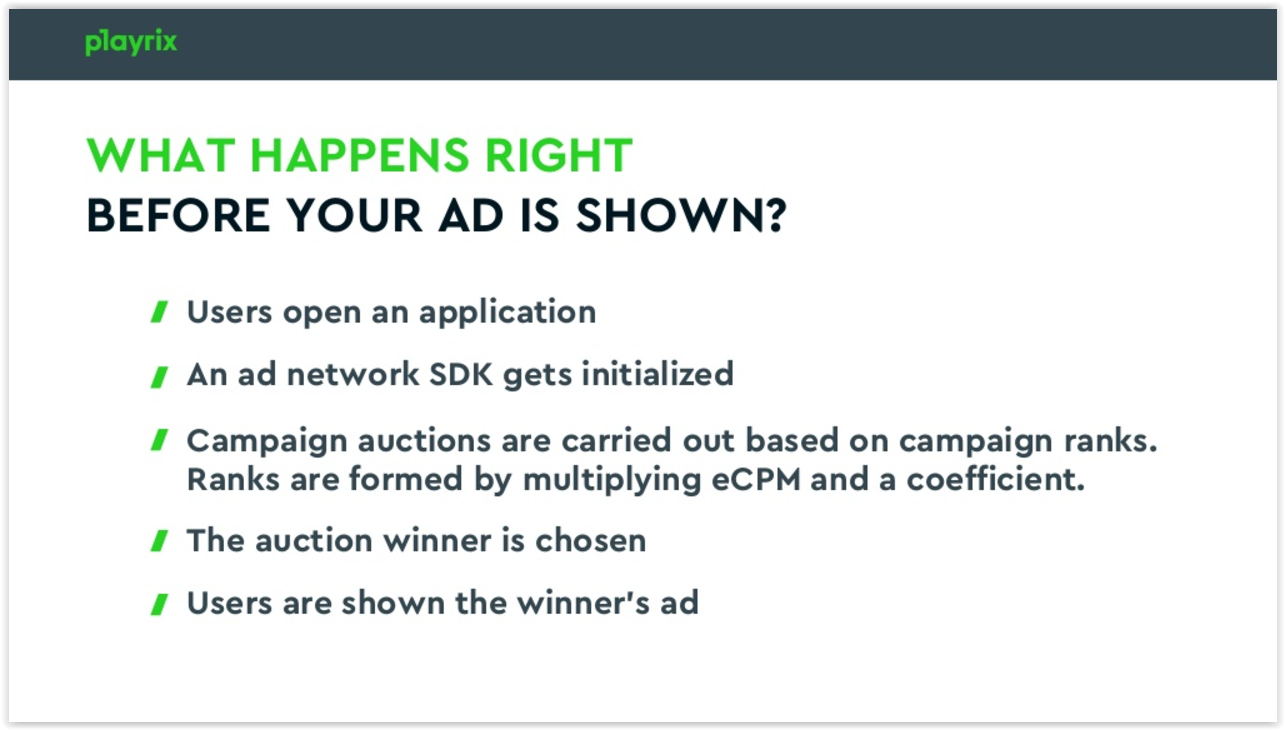
Consider a special case, for example, a player enters a solitaire.
In solitaire, advertising is arranged as follows: the user opens the solitaire, starts playing, wins his level and reaches the place where advertising is shown in the game.
At this moment, the most interesting thing begins inside the game — the SDKs of various networks are initialized.
What does this mean?
You can find the same person — a unit of traffic — on different channels, from different publishers.
There are two reasons for this. The first is that the same person has a different number of applications installed, different games, social networks, and so on. Accordingly, you can reach it through many sources.
The second is that each application that has advertising integrates various SDKs of networks. The same solitaire considered in the example may contain Facebook ads, Google ads, ironSource ads, or something else. This is an absolutely normal situation.
Let’s get back to the game. It turns out that the SDK is initialized, and the networks receive information that the user is ready to view the ad. A portrait of the audience begins to be drawn up, internal processes take place. As a result, after collecting statistics, an auction begins to be held.
What is an auction?
Each impression that occurs specifically to this person in solitaire is played out between different networks and different advertisers.
The auction is conducted on the basis of two conditional metrics: eCPM and weight coefficients. According to the results of the auction, there is a winner among advertisers who participate in this auction and advertise specifically on this tapeworm.
As a result, the player sees the winner’s advertisement.
But there is a nuance.
When a person enters the game, he sees the ad for the first time. If he keeps playing, he sees her a second time, a third, a fourth. The sooner you show the ad, the better.
Why?
- The more ads he sees, the more tired he gets, the more his eye gets blurred.
- During the first ad impressions, the user is still interested, he wants to play, and he will react better to your advertising.
- After watching the advertisement, the user either stays in the solitaire, or goes to the game whose advertisement he saw. In the latter case, if you are shown somewhere in 10th place, you will not see a very large share of the audience that will go to other applications.
For now, remember this, and I’ll tell you why it’s important a little later.
Why is traffic getting more expensive?
Here is an approximate graph of what Playrix sees in the traffic market over the past couple of years.
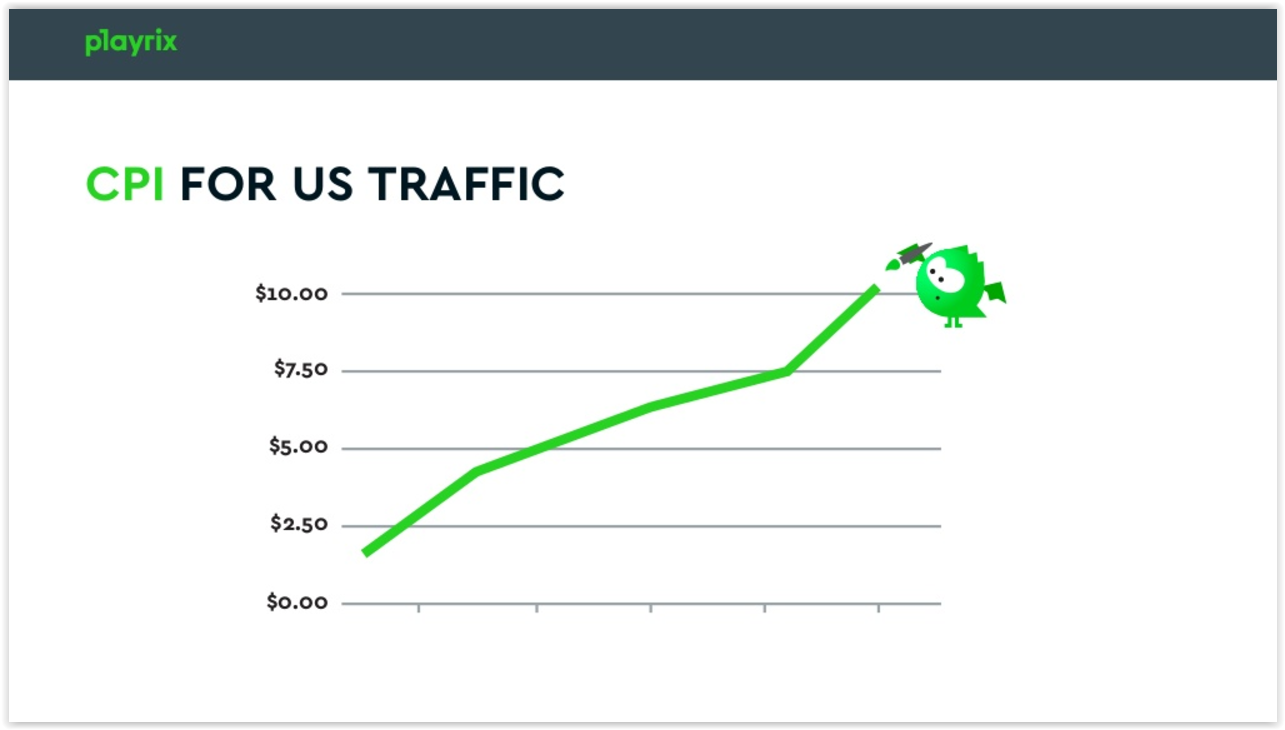
If earlier it was possible to enter the US market with bids of $ 2, $3, $4 and buy good traffic, now these bids have grown very much.
Why is traffic becoming so expensive?
The first reason for the rise in price of traffic is competition
First of all, because of the competition, which we have already talked about.
As I have already mentioned, the earlier the impression you get, the greater the share of quality traffic you win. And everyone, of course, wants their project to be shown first.
To do this, increase the bid, that is, the bid, the price for the installation that you are willing to pay.
And let’s imagine a situation: you buy advertising in some kind of grid. And you found some kind of publisher, that is, a good application in which you place ads and from which you get a good LTV.
You see a cool result and want to get even more. You raise the bid to get more traffic.
But at the same time, competitors — other advertisers who saw a good result from the same publisher — see a drawdown in their old bids, because you dragged some of the traffic to yourself.
Naturally, they don’t want to lose the traffic that has gone. They’re upping the ante, too.
This process is called “auction overheating”.
You raised the bid, competitors raised the bid, the volume remained in the same place, but you are already paying more for it.
You can continue to compete further: you raise the bid, they raise the bid if their income allows them to spend more per installation. As a result, this struggle leads to a situation where it is unprofitable for any advertiser, and the grid earns from this, because the average income earned from advertisers increases, while the quality of users from this situation does not change in any way.
A similar situation may arise with some not entirely correct information that grids sometimes give.
Example: you buy some kind of publisher, traffic from some kind of application, which gives a very good result. Everything suits you. At some point, the advertising network says that a competitor will come soon who wants to buy the same publisher, but at a much higher price. The network tells you which bid to put, you put it and start buying more expensive. Competitors do the same. They also raise bids, you raise bids, and so on. Although in fact, this competitor, who will come and bid higher, might not have been. This may be a kind of misinformation that was launched to start growing bids.
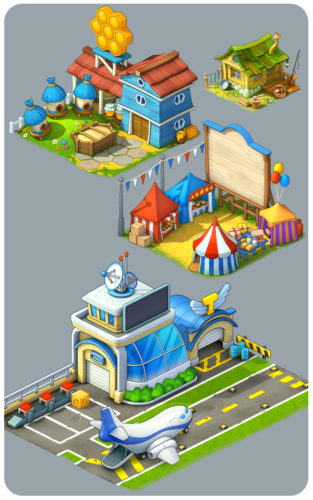
Art to Township
Such situations happen, and it is very important to build trusting and respectful, good relations with the grids, so that there are no such situations.
The second reason for the rise in price of traffic is resale
Traffic is divided into direct and indirect.
Direct traffic is when you work with some channel that has its own audience, and this channel resells its audience to you.
Indirect traffic is when you work with an agency that buys traffic from someone else.
Indirect traffic can be bought by several agencies, while each reseller will inflate the price for the installation. He will increase it by the cost of his commission.
There are cases when the original source sold the installation for $3, and you bought it for $7. This suggests that there were a lot of resellers in this chain from $3 to $7.
Playrix has faced situations when overbought were in 5 hands or more. There are even such absurd situations when an offer about traffic leaves one agency and, cyclically passing through many others, returns back. This is a real picture, it happens. This naturally increases the price of traffic out of the blue.
Naturally, such a situation with the purchase of traffic in no way increases the quality of traffic. The same traffic, passing through many and many hands, increases in price, but remains unchanged in quality.
The third reason for the rise in price of traffic is internal competition
Another point that may make traffic more expensive is internal competition.
We had such a case: we bought branded traffic on different accounts of the same channel.
There were a lot of people in the team, everyone bought on the same channel, and it so happened that two account managers bought the same targeting on different channels. The first raises the bid — the volume of the second falls. The second raises the bid — the volume of the first falls. And this heating up of the auction on its own really happened.
How to cope with the increase in bids?
It is important to realize that advertisers have completely different needs. The genres of games are different, monetization is different. Someone has the opportunity to buy traffic for $ 20-50, someone does not have such an opportunity. You need to properly assess your strength, your margin of safety, your LTV and set adequate bids, that is, raise the rates to the level where it is beneficial to you.
When the auction overheats, when everyone raises bids higher and higher, you control your purchase, but what advertisers will do is a mystery to us. Therefore, if you feel that another increase in the bid, and you will already be in the red, then it is easier to find this particular publisher on which you saw overheating, and go, for example, to another grid.
That is, you bought it on one grid, saw this frenzied CPI and went to buy the same publisher on another. Gradually, the auction on the first grid will cool down and everything will return to its place.

Art to Fishdom
It is very important to build a transparent, correct, open relationship with a partner, to conclude an NDA.
What is an NDA?
This is a non-disclosure agreement, a confidentiality agreement. In this case, you can be completely open and be in information security with your partner, as well as share information about your products, about some plans, about strategies. This helps you select the right purchasing strategy that will suit you and your product individually.
The next point is transparency. Why is it so important? Some networks and partners may share metrics that will tell you your position on the channel, that is, how many impressions you buy, how high you are in the top of advertisers for purchased impressions and what CPM, for example, is needed in order to be in first place.
Here you need to understand one important thing: if a channel gives you a win rate or a percentage of purchased impressions, this is good, but it does not always give you the information you are waiting for, because if they tell you that you are buying, for example, 10% of impressions, and nothing else, you can draw several conclusions. You may decide that “I’m buying back 10% on this major channel, so I’m doing well!” At the same time, there may be another 10 advertisers who overtake you and buy much more by a large margin. And at the same time, it may be that you are really in one of the first places and everything is very good.
Transparency can be different, you need to understand which metrics will help you, which won’t, and which will provide you with the right level of information.
The next important point is understanding how the channel mechanisms work. Without a full understanding of this process, you will not be able to use the full potential.
We had such examples when we started working with the channel, and it turned out that we worked with it for, for example, a year, and everything went well, there was some volume, everything paid off, but at the same time we understood that this was far from the limit. And by starting to communicate in more detail, in more detail and openly with a partner, we realized that there really are things that we didn’t do, that we didn’t realize — things that really help to grow. Because you need to understand the only point — the mechanisms and algorithms on each channel are different, but at the same time these mechanisms and algorithms are, in fact, the product of each grid. It’s their secret. That is, they will not tell you all the secrets, all the nuances of the algorithm, but at the same time they can direct you in the right direction, give you all the tips, and you can actually increase the profit, increase the volume.
In order not to overheat the auction itself, you need to look very carefully at all your actions on the same channel, monitor fluctuations, correlations, changes in some quantities. And track the intersection of the audience.
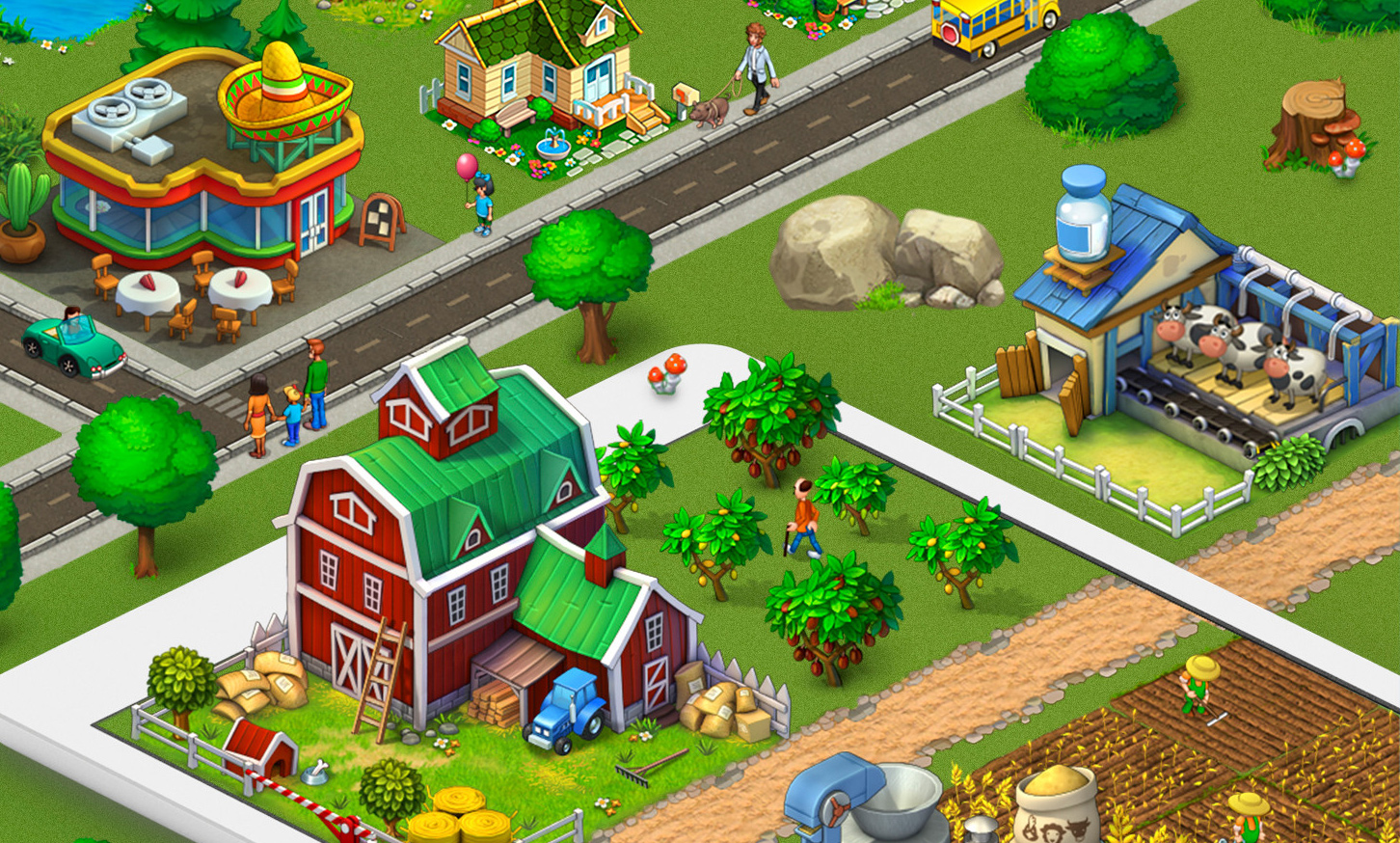
Township
Another important point is that when you buy traffic for a specific bid, you see the volume and realize that you are not satisfied with this volume, you want more and you have a payback. You can afford to raise the bid. You raise it. The volume is increasing. You see that everything is fine again and raise the bid even more. And you see that at some point the correlation of bid increase and volume increase is not so big anymore. You increase the bid, for example, by 10%, and the volume increases not by 10%, but by 5%. You raise another 10% — it goes up by 3%, and so on, and so on. And here you need to understand that elasticity decreases over time and you cannot increase the volume indefinitely. The situation here is that at some point, when you raise the bid higher and higher, you no longer see any effect in the volume. Then why do it, why raise the bid?
In principle, these are the main things that I wanted to tell you about how to deal with expensive traffic, how to buy it cheaper and what mistakes should not be made so as not to overpay.